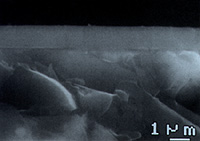By Allan Chen
A unique plasma-based process for depositing high-temperature protective coatings promises to improve the efficiency and reduce the wear and tear of technologies ranging from engines to hip joints. The plasma deposition process for these coatings was developed by a team of scientists at Berkeley Lab's Accelerator and Fusion Research Division.
"High-temperature protective coatings make advanced heat engines more efficient, because the engine parts - turbine blades and pipes for example - can run at higher temperatures," says Ian Brown, leader of the Plasma Applications group that developed the new process. "The smooth surfaces of these coatings also minimize the wear of moving parts."
The potential impact of better coatings on the efficiency and working life of all types of technologies subject to heat stress and mechanical wear and tear is so large that materials scientists are searching continually for better coatings.
Invited by the Department of Energy's Fossil Energy Advanced Materials Office to investigate the potential of plasma deposition to high-temperature coatings, Brown, staff scientist Othon Monteiro, and others in the group began to investigate how plasma deposition might be used to form films of oxide ceramics, which can resist oxidation at temperatures of 2,000 to 3,000 deg.F.
"You want the film to persist, and not flake off after repeated increases and decreases in temperature. It must maintain its ability to stop oxidation," says Brown. Smoothness and uniformity of the surface are also important.
 |
|
An edge-on scanning electron microscope photograph of a thin film of mullite formed by the dual-source deposition process. Aluminum and silicon plasmas were combined in a low pressure background of oxygen to form the mullite structure.
|
The group has so far worked with two types of high-temperature ceramic films, alumina (aluminum oxide) and mullite (a mixture of alumina and silica¬silicon oxide), because they have a strong tolerance for high temperatures. Mullite is a particularly good coating for silicon carbide, a ceramic material with important high-temperature technology applications.
"We make the films in a novel way," says Brown, "using metal plasmas and ion beams." Solid aluminum, silicon or other material is turned into a stream of charged particles (the plasma) using a powerful electrical current in a device called a plasma gun.
The particles shoot out of the gun and into a curved metal coil shaped like a slinky straddling two stairs. The coil is magnetized, and helps filter and purify the plasma stream by deflecting only the charged particles (called ions) of aluminum or silicon through the coil.
"We add oxygen to produce the right amount of oxide," says Brown. The plasma stream hits the substrate, coating it. In the laboratory, the substrate is often a one-centimeter square of a material like silicon carbide. Brown says that there are no technical barriers to scaling up this process to industrial uses.
One advantage of plasma deposition with energetic ion bombardment is its ability to create a good bond between coating and substrate. "These films have an ion beam-mixed interface; that is, they are atomically mixed to the substrate, and the adhesion is very strong" says Brown.
Another benefit of the process is its ability to produce a very smooth coating. "By adjusting the ion energy," according to Brown, "we can get films that are very dense: no voids¬very smooth and uniform." In other processes such as a widely used approach called sputtering, the particles of coating material are not charged, so it's more difficult to control the characteristics of the film.
The researchers have also used plasma deposition to form high-quality films of diamond-like carbon (DLC), an important industrial coating that is valued for its extreme hardness. They are also creating and studying multilayer films. Using the plasma process they can deposit a coat of, for example, silicon carbide, and then a coat of DLC, followed by more alternating layers of the two. Multilayer coats may adhere to their substrates better, or combine the best features of two or more coatings in one.
"A lot of the starting equipment for this process is already available commercially," says Brown. "It starts with physical vapor deposition machinery, and then needs some additional bells and whistles, some that are also available on the market."
Beyond improving advanced engines and other types of machinery with moving parts, Brown speculates that the coatings have applications in the biomechanical realm. "I think these materials have a future for orthopedic prostheses¬hips and knee joints, for example. These artificial joints must stand up to wear and tear and last as long as possible.
"The coatings could also produce cheaper and better artificial teeth. Currently, replacement teeth are made of gold. They could be made out of titanium with a ceramic coating that bonds well at the metal-ceramic interface," says Brown.
Monteiro, Brown, Zhi Wang, Kin Yu and Peggy Hou of Berkeley Lab, and B.H. Rabin and G.F. Kessinger of the Idaho National Engineering Laboratory, described their work on plasma deposition at the 10th Annual Conference on Fossil Energy Materials in Oak Ridge, Tennessee.

